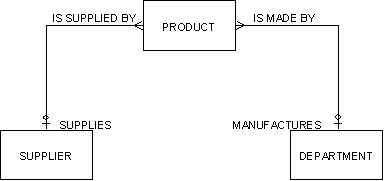

Consider the case where the PRODUCT entities are either manufactured by an internal manufacturing DEPARTMENT or purchased from a SUPPLIER. Assume that each PRODUCT can be acquired from only one source. In other words, each PRODUCT entity either is supplied by a SUPPLIER or is made by a DEPARTMENT, but never both. Here, the existence of a pairing that is based on one of the relationships precludes the existence of one based on the other. For a given entity type, relationship memberships whose occurrences preclude the existence of occurrences of other relationship memberships are said to be mutually exclusive of one another as shown in the following illustration.

More than two relationship memberships can be mutually exclusive. For example, PRODUCT could also be stocked by SUPPLIER, for shipment direct to customers. A relationship membership that is involved in a mutually exclusive set must be optional, and may not therefore be part of an identifier.
In CA Gen, mutual exclusivity of a set of relationship memberships is recorded when defining the entity type to which the relationship memberships belong. Analysts specify up to five sets of mutually exclusive relationship memberships for each entity type.
|
Copyright © 2014 CA.
All rights reserved.
|
|